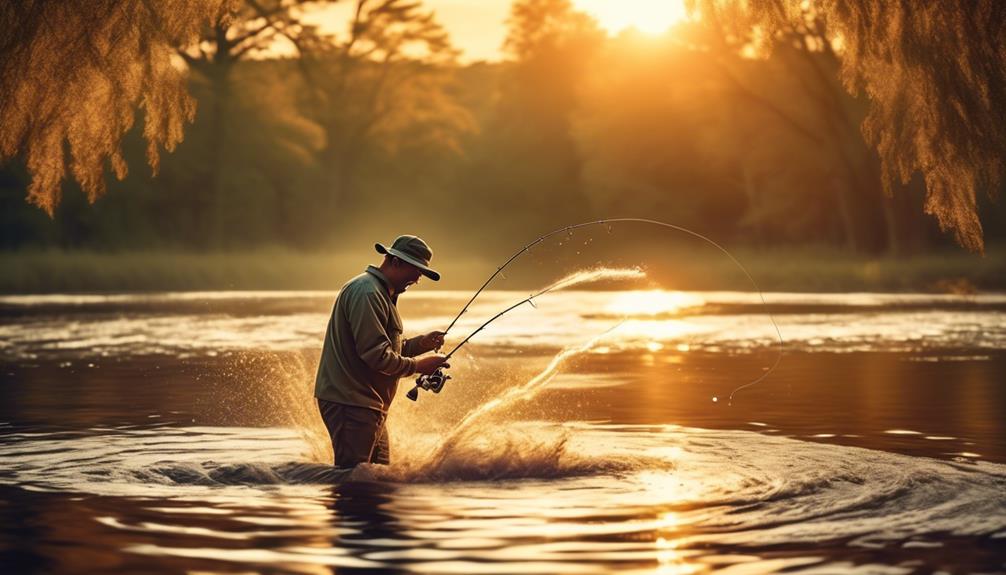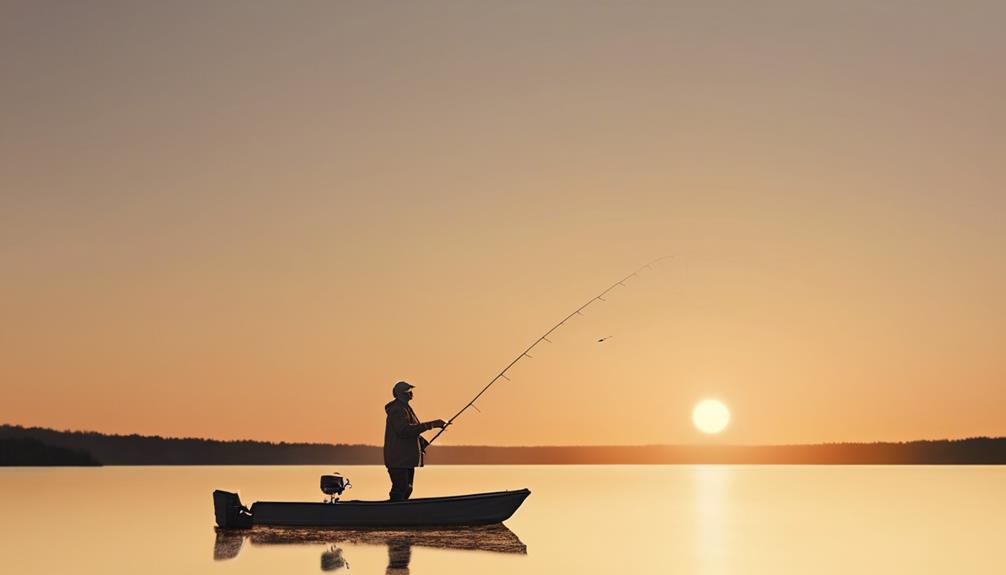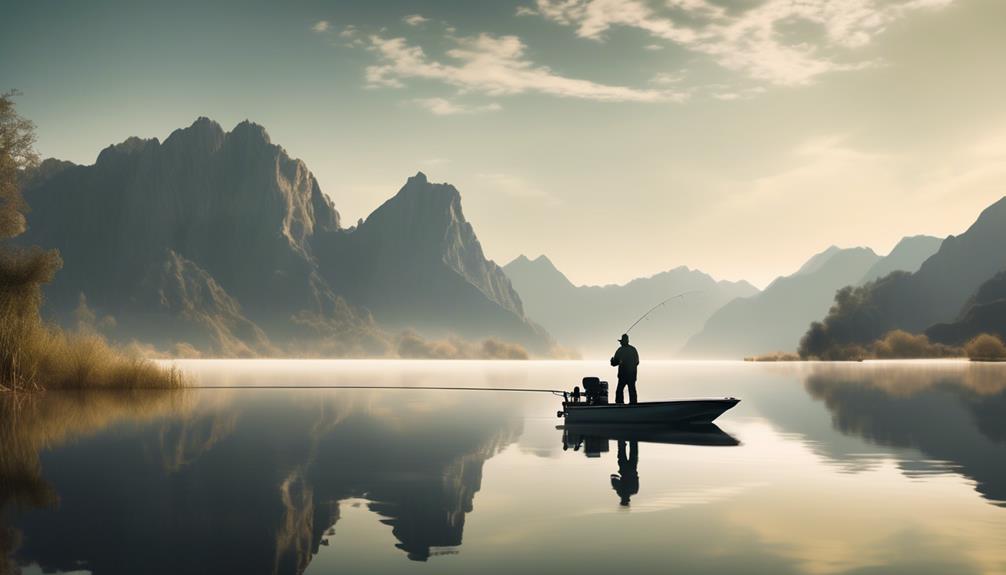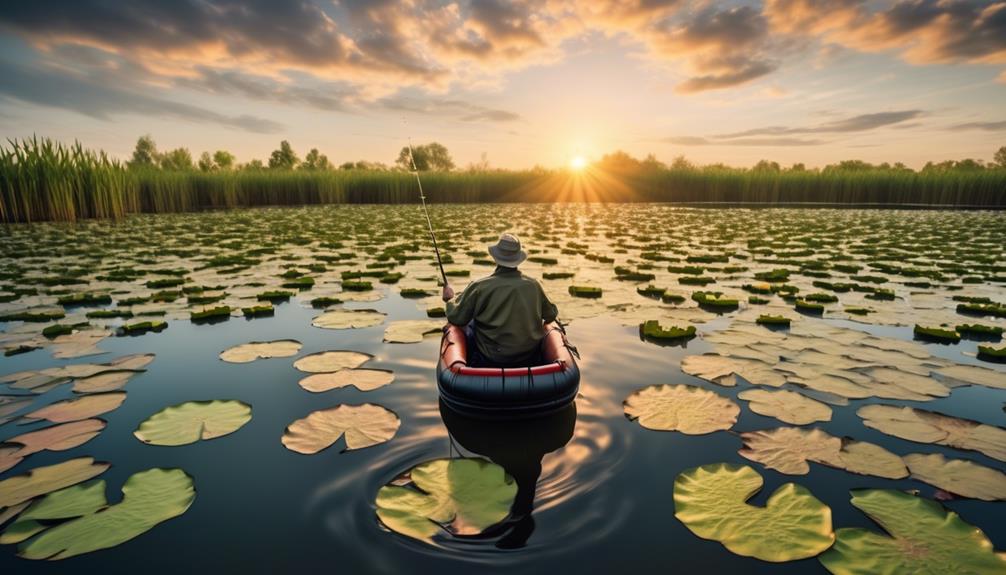If you're an avid angler, you'll be intrigued to learn that bass fishing generates over $70 billion in economic activity in the United States each year.
When it comes to river bass fishing, mastering the right techniques can make all the difference between a successful outing and going home empty-handed. From navigating river currents to understanding bass feeding habits, there are 12 expert techniques that can elevate your river bass fishing game to the next level.
Whether you're a seasoned angler or just starting out, these techniques will help you reel in more bass and make the most of your time on the water.
Locating River Bass Hotspots
To improve your success in river bass fishing, you should focus on locating hotspots where bass tend to congregate. Understanding river terrain is crucial for finding these hotspots. Look for areas where the riverbed changes, such as where the current slows down or speeds up, and where there are structures like rocks, fallen trees, or submerged logs. These are prime locations where bass like to hide and feed. Pay attention to the water temperature as well. Bass are cold-blooded and their activity levels are greatly influenced by water temperature. During the warmer months, bass tend to move into shallow, warmer waters, while in colder months, they often seek out deeper, warmer areas. Understanding these temperature preferences can help you pinpoint bass hotspots more effectively.
River terrain offers a diverse range of habitats for bass to thrive in. Keep an eye out for areas where there's a change in the riverbed structure, such as points, eddies, and shoals. These are all potential hotspots for bass. Additionally, river currents create oxygen-rich environments which attract baitfish, and in turn, bass. Look for areas where the current breaks, creating pockets of slower water, as these are often bass magnets.
When it comes to water temperature, understanding the seasonal changes is crucial. During the spring, bass tend to move into shallow waters to spawn, whereas in the summer, they may seek deeper, cooler areas. In the fall, they often move to shallower waters again to feed before winter. By paying attention to these temperature patterns, you can increase your chances of locating productive bass hotspots.
Mastering Topwater Lure Techniques
Mastering topwater lure techniques allows you to capitalize on the bass hotspots you've identified in the river, enticing strikes from these elusive fish in exciting and visually captivating ways. When it comes to surface strikes, your lure presentation is crucial. To maximize your chances of attracting bass, consider using lures that mimic natural prey and create a commotion on the water's surface. The key is to make the bass believe that an easy and irresistible meal is within reach.
Topwater action is all about triggering bass aggression. By mastering the art of working topwater lures, you can incite explosive strikes from bass that are lurking near the surface. One effective technique is the 'walk-the-dog' retrieve, where you impart a side-to-side action on the lure, simulating a wounded or disoriented prey. This erratic movement can trigger aggressive strikes from bass, especially during low light conditions or in areas with heavy cover.
Additionally, mastering the timing of your topwater presentations is crucial. Bass tend to be more active near the surface during low light periods such as dawn, dusk, or cloudy days. Targeting these times can significantly increase your chances of success with topwater lures.
Navigating River Currents for Bass
Navigating river currents when bass fishing requires keen observation and an understanding of how the water flow influences bass behavior. The movement of river currents impacts the behavior and positioning of bass, making it crucial to develop a sound fishing strategy that takes into account water dynamics.
To effectively navigate river currents for bass, start by observing the flow of the water. Look for areas where the current slows down, such as eddies, slack water behind obstructions, or along the riverbank. Bass often seek refuge in these calmer waters, conserving energy while waiting for prey to be carried by the current. Understanding these water dynamics helps in identifying prime spots to target bass.
When devising a fishing strategy, consider casting your lure upstream and allowing it to drift naturally with the current. This mimics the movement of natural prey and can entice bass into striking. Additionally, be mindful of the speed and force of the current, as it can affect the presentation of your lure. Adjust your retrieval speed and technique to match the flow of the water, ensuring a natural and enticing presentation.
It's important to note that river currents can change throughout the day due to factors such as tides, rainfall, or dam releases. Continuously monitor the water dynamics and adapt your fishing strategy accordingly to maximize your chances of a successful bass fishing expedition.
Perfecting Pitching and Flipping
As you observe the flow of the river currents for bass fishing, mastering the art of pitching and flipping becomes essential for precisely targeting bass in their preferred hideouts. Improving accuracy and controlling distance are crucial elements in perfecting these techniques. Precision casting allows you to place your bait with pinpoint accuracy, increasing the chances of enticing bass from their cover. By honing your pitching and flipping skills, you can deliver your bait directly to the bass's hideout, presenting it in a natural and enticing manner.
When perfecting pitching and flipping, focus on your wrist motion and the release point to improve accuracy. Keep your movements smooth and controlled to avoid spooking the bass, and practice different release angles to master the art of controlling distance. Additionally, pay attention to your bait presentation. Once your bait lands in the target zone, be ready to manipulate it subtly, mimicking natural movements to entice the bass into striking. Adjust the tension on your line to control the descent of your bait and make it appear as natural as possible.
Understanding River Bass Feeding Habits
To better target bass in river currents, understanding their feeding habits is crucial for increasing your fishing success. Bass feeding patterns exhibit seasonal variations, which directly impact their behavior and preferred prey. By comprehending these patterns, you can strategically plan your fishing approach throughout the year.
- Seasonal Variations: Bass feeding habits change with the seasons. In spring, they're voracious feeders as they prepare for spawning. During summer, bass are more selective due to warmer water temperatures. In fall, they aggressively feed to store energy for the upcoming winter. Winter sees a decrease in their metabolism, leading to more sluggish feeding behavior.
- Prey Items: Understanding the river bass diet is essential. Bass primarily feed on a variety of natural prey items such as shad, minnows, crawfish, and insects. Knowing their preferred prey allows you to choose the most effective lures and baits.
- Feeding Locations: Bass tend to feed in specific areas depending on the time of year. During spring and fall, they often move into shallower waters in search of food. In summer, they may seek deeper, cooler waters. In winter, they're more lethargic and may be found in deeper, slow-moving areas.
- Adaptation: River bass are adaptable predators and will adjust their feeding behavior based on environmental conditions, water clarity, and available forage. Understanding these adaptations can help you anticipate their movements and feeding preferences.
Tackling River Bass With Soft Plastics
Understanding river bass feeding habits is crucial for increasing your fishing success. One effective method for targeting them is by utilizing soft plastics. River bass are often found near structures such as fallen trees, rocks, and vegetation, so using soft plastics that mimic natural prey can be highly effective. To maximize your chances of a successful catch, it's important to pay close attention to your river bass presentation.
Soft plastic retrieval involves casting your bait near these structures and using a variety of techniques to mimic the movement of prey. One effective method is the 'jig and pig' technique, where you use a jig head to make the soft plastic bait appear as if it's hopping along the riverbed. This can trigger a predatory response from bass that are hiding in wait. Another technique is the 'Texas rig,' where the soft plastic bait is rigged weedless, allowing it to be pulled through heavy cover without getting snagged. This can be particularly effective in areas with dense vegetation where river bass often lurk.
When it comes to river bass presentation, it's important to vary your retrieval speed and style to find what works best on any given day. Sometimes a slow, subtle movement can entice river bass, while other times a more erratic and aggressive retrieval may be necessary to trigger a strike. By experimenting with different soft plastic retrieval techniques and river bass presentations, you can increase your chances of a successful fishing trip.
Cracking the Code of River Bass Behavior
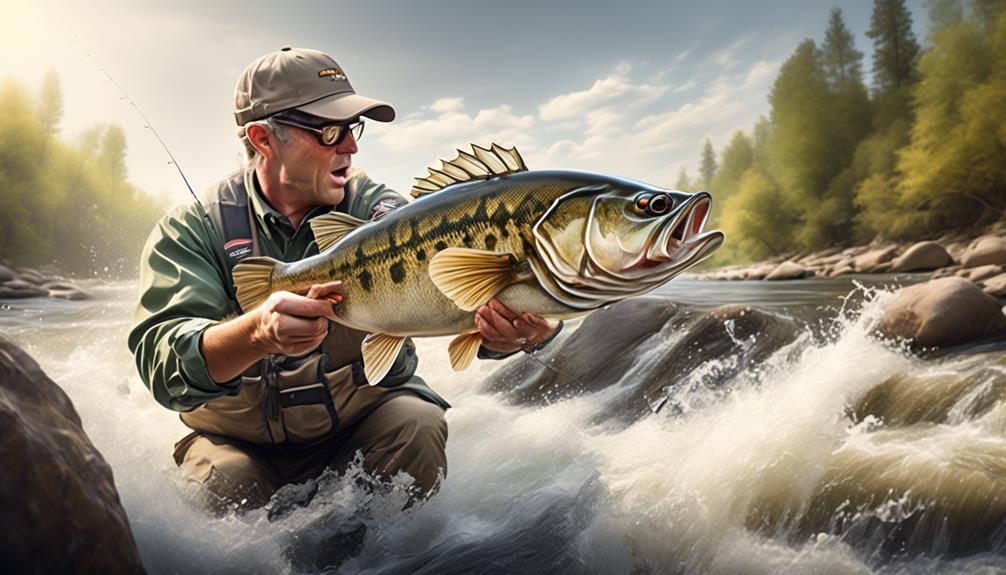
Unravel the mystery of river bass behavior to enhance your angling success and understanding of their habits. To maximize your fishing experience, it's crucial to comprehend the intricacies of bass behavior, especially in rivers.
- Understanding Bass Migration: Bass are known for their seasonal migrations in rivers. During the warmer months, they often move to shallower waters near the river banks to feed, while in colder months, they may migrate to deeper, calmer areas to seek warmth and conserve energy.
- River Bass Spawning Behaviors: Understanding the spawning behaviors of river bass is essential. Typically, bass spawn in the spring when water temperatures reach around 60-75°F. During this time, they seek out shallow, gravelly areas to build nests and lay their eggs. Identifying these spawning grounds can greatly increase your chances of catching bass.
- Impacts of River Conditions: Factors such as water flow, temperature, and clarity significantly influence bass behavior. High water flow may push bass to seek calmer areas, while changes in water temperature can affect their feeding patterns.
- Adaptation to Environmental Changes: Bass are adaptable creatures. They adjust their behavior based on environmental changes, such as fluctuating water levels or the presence of natural or artificial structures.
Fine-Tuning River Bass Jigging Methods
Fine-tune your river bass jigging methods by observing the impact of river conditions and adapting to environmental changes.
When it comes to adjusting your jigging techniques, paying attention to the jigging depth and retrieval speed is crucial. In fast-flowing waters, bass tend to hold deeper, so you may need to jig your bait at a lower depth to reach them effectively. Conversely, in slower currents, bass may be more spread out, so varying your jigging depth and experimenting with different retrieval speeds can help you pinpoint their location.
Spinnerbait variations can also play a key role in fine-tuning your river bass jigging methods. Different spinnerbait styles, such as willow leaf, Colorado, or Indiana blades, can produce varying vibrations and flash under the water. In murky or stained river conditions, opting for spinnerbaits with larger, more pronounced blades can help bass locate your bait more easily. On the other hand, in clear water, downsizing to smaller blades with subtler vibrations can yield better results.
Frequently Asked Questions
What Are the Best Strategies for Fishing in Heavily Wooded Areas Along the Riverbanks?
When fishing in heavily wooded areas along the riverbanks, focus on casting accuracy to reach tight spots. Choose lures that resemble natural prey and can navigate through obstacles. This strategy increases your chances of catching bass in these challenging environments.
How Can I Effectively Use Live Bait to Attract River Bass in Fast-Moving Currents?
To effectively use live bait in fast currents for river bass, present it naturally near cover and eddies. River bass are opportunistic feeders and will be drawn to live bait that mimics their natural prey.
What Are Some Tips for Fishing in Low-Light Conditions, Such as Early Morning or Late Evening?
When fishing in low-light conditions like early morning or late evening, choose lures that create contrast and vibration. Use darker colors for better visibility. Practice accurate casting techniques by aiming for areas with potential fish activity.
Are There Any Specific Techniques for Targeting Larger, Trophy-Sized River Bass?
When targeting larger river bass, focus on lure selection and presentation. Use larger lures to entice trophy-sized bass. Practice catch and release and conservation to preserve the bass population for future fishing opportunities.
How Can I Adjust My Fishing Approach When the River Water Levels Are Unusually High or Low?
When the river water levels are unusually high or low, adapt your fishing techniques for extreme conditions. In high water, focus on areas with slower currents and use larger lures. In low water, target deeper pools and use smaller, more natural-looking lures.
Conclusion
Now that you've learned these expert river bass fishing techniques, you're ready to tackle any river and reel in some impressive catches.
Remember to keep practicing and experimenting with different methods to find what works best for you.
With patience and persistence, you'll become a master at river bass fishing and enjoy the thrill of landing those elusive river bass.
Happy fishing!
